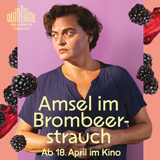
Neue Notiz
Futatsume no mado
Kaito and Kyoko live on a tropical island in the very south of Japan. First love blossoms, as events in their families force them to review their positions in life.
STILL THE WATER begins and ends with the sea. In the beginning the powerful blue waves hit the rocks, evoking a Hokusai image come to life and the film ends with a few air bubbles rising from the sea floor onto the surface. The image of the wave, which builds slowly and gathers energy, powerfully culminating and tapering off at the end as if it had been a gentle stream all along, is represented in many ways by director Naomi Kawase. Kaito and Kyoko are around 16 and live in a subtropic island in the South of Japan. They become each other’s first love and, at the same time, are challenged to position themselves about life due to the situation in their respective families. Kaito’s parents have separated and he lives with his mother who begins a new relationship, something he can’t understand, while the father, a tattoo artist in distant Tokyo, still talks about the bond he has with his ex. Kyoko’s mother is dying though she is a shaman and should have privileged access to magical and healing powers.
The sea accompanies them throughout their path. For Kyoko, an island child, it is a natural element she can enjoy fearlessly and with relish, even after a drowned person is found and swimming is prohibited. Kaito, on the other hand, is a boy from Tokyo who fears the sea as one can never know what you might find in there. When the teens question Kyoko’s mother’s mortality, a great uncle explains that even Gods have an expiration date. This tone of respect and acceptance is present throughout the film. Kawase does not shy away from giving the adults the space to share their views. Village society enables the intergenerational closeness, a thing which would be impossible to imagine in the hectic and work-focused big city.
Kawase’s successful directing turn is best seen when the mother returns home from the hospital facing unavoidable death. Kyoko and her parents sit together on the terrace underneath the ramified banyan tree, a 400 year old strangler fig that clearly symbolizes the connection between all things. The exchange between the three is marked by cheeriness and affection, a fleeting, magical moment. The unavoidable is reacted upon with humor and lightness, without suppression. The attitude is partly achieved through practice and partly a question of will, something that Kyoko observes at a different point: even if I or someone else cannot understand, I can decide to make peace with it.
Translation: Elinor Lewy
Original title: Futatsume no mado
Frankreich/Japan/Spanien 2014, 118 min
Genre: Drama, Love Stories
Director: Naomi Kawase
Author: Naomi Kawase
DOP: Yutaka Yamazaki
Montage: Tina Baz
Music: Hasiken
Distributor: Film Kino Text
Cast: Nijirô Murakami, Jun Yoshinaga, Miyuki Matsuda
FSK: 6
Release: 30.07.2015
Website
IMDB
Screenings
- OV Original version
- OmU Original with German subtitles
- OmeU Original with English subtitles
Keine Programmdaten vorhanden.
ALLE ANGABEN OHNE GEWÄHR.
Die Inhalte dieser Webseite dürfen nicht gehandelt oder weitergegeben werden. Jede Vervielfältigung, Veröffentlichung oder andere Nutzung dieser Inhalte ist verboten, soweit die INDIEKINO BERLIN UG (haftungsbeschränkt) nicht ausdrücklich schriftlich ihr Einverständnis erklärt hat.




